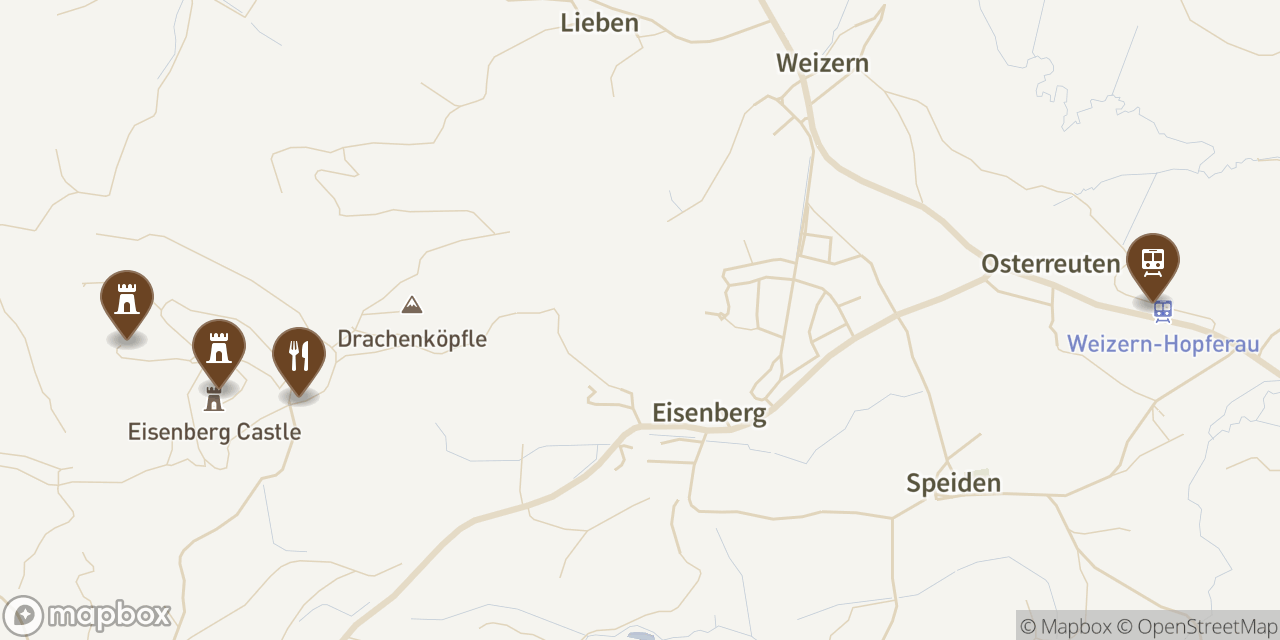Explore two authentic medieval castle ruins away from tourist crowds
Experience breathtaking panoramic views of the Bavarian countryside
Easy hiking trails connecting multiple villages
Perfect spot for a scenic mountain picnic
Why We Love This Trip
Interactive Map

Points of Interest
Your Day Trip Timeline
Take the BRB train from Munich towards Füssen and Neuschwanstein
Arrive early to get a seat of this train as it is very popular
Disembark at the tiny rural station of Weizern-Hopferau
Only 30-second stop - be ready to exit quickly
Walk through residential village
Basic residential area, not particularly scenic. Find hand-painted map at village entrance
Follow rural trails through cow pastures
Warning: Some steep sections. Multiple paths connect different towns to castles
Enjoy spectacular Bavarian viewpoints
Some of Bavaria's best panoramas. On clear days, spot Neuschwanstein in distance
Explore Castle Eisenberg (built 1313)
Perfect picnic spot with stunning views. Best viewpoint from front guard tower
6-minute walk to Hohenfeyburg Castle
More extensive ruins with many corridors to explore
Optional visit to local Gasthaus
Well-deserved rest after the challenging but rewarding hike
Return via connecting trails
Choose from multiple path options back to different nearby towns
Note: If the day isn't over, you can continue to Füssen and visit the Neuschwanstein Castle
This is a 15-minute train ride away, and you can easily combine the two in a day trip
Ben's Deep Dive
Beyond the tourist crowds lies a fascinating tale of medieval spite, aristocratic rivalry, and peasant uprisings that shaped these twin castle ruins into authentic windows to Bavaria's turbulent past.
The story of Eisenberg and Hohen Feyerburg castles reveals a captivating chapter of medieval German history that extends far beyond their scenic mountaintop locations. Eisenberg Castle, constructed in 1313, emerged from conflict and defeat when the nobles of Poetic were swiftly driven from their original stronghold by the Tyroleans. Rather than retreat in shame, these displaced nobles established their new lordship in the town of Eisenberg and began an ambitious building project that would define their legacy.
What makes this castle truly unique is its construction as a "spite castle" - a fortress built more for vanity and psychological warfare than practical defense. The nobles invested heavily in the castle's aesthetics, including a distinctive high wall designed to create the illusion of a tower, prioritizing appearance over military functionality in what can only be described as medieval peacocking.
The construction of Hohen Feyerburg in 1418 adds another layer to this aristocratic drama. Built by the Lord of Eisenberg's son just a seven-minute walk from the original castle, this second fortress represents more than simple defensive expansion. Scholars theorize that its deliberately archaic 15th-century design, mimicking architectural styles from 200 years prior, reflects the German nobility's growing unease about their waning influence as the bourgeois class rose to power.
This architectural choice wasn't accidental - it was a calculated attempt to project an image of unbroken aristocratic lineage and enduring power. The similarities between the two castles weren't coincidental but rather a conscious effort to create a unified statement of noble authority across the hilltops.
The dramatic downfall of these castles tells the broader story of social upheaval in medieval Germany. In 1525, Eisenberg Castle faced its ultimate test during the German Peasants' War, when it was immediately overrun and badly damaged by peasant rebels. The castle's emphasis on aesthetics over defense proved fatal - its spite-driven construction offered little protection against determined attackers.
Ironically, Hohen Feyerburg, despite being built with similar vanity, managed to successfully fend off the peasant uprising, demonstrating that even aristocratic peacocking could sometimes yield practical results. Both castles ultimately met their complete ruination in 1646 during the Thirty Years' War, when Austrian forces systematically burned down all fortifications in the surrounding area, ending centuries of noble dominance in the region.
Today, these ruins offer visitors an authentic connection to Bavaria's interconnected medieval landscape that commercial attractions simply cannot match. The strategic positioning of both castles provides breathtaking panoramic views across the countryside, revealing the network of small towns that have existed in symbiosis with these fortifications for over 700 years.
Unlike the fantasy-inspired architecture of nearby tourist destinations, these genuine medieval structures allow visitors to stand in the actual guard towers where sentries once watched over the plains, controlled trade routes, and collected taxes from the communities below. The fact that multiple hiking trails from various towns converge at these castle sites demonstrates how these fortifications served as genuine focal points for medieval life, creating the interconnected historical experience that makes exploring these ruins so compelling for those seeking to understand Bavaria's authentic medieval heritage.
Support Us
Plan Your Trip
Get personalized recommendations and custom itineraries for your Munich adventure. Whether you need help planning the perfect day trip, finding hidden gems, or creating a multi-day itinerary, we're here to make your Munich experience unforgettable.
| Consultation | Time |
|---|---|
| Quick Q&A | 20 min |
| Tailored Consultation | 45 min |
Join Our Tours
Experience Munich like a local with our personalized walking tours and full-day adventures! From hidden gems to local favorites, we'll show you the authentic side of Munich that most tourists miss.